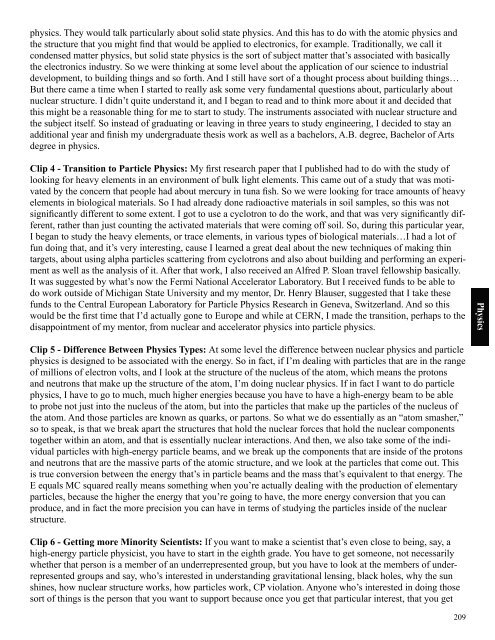ScienceMakers Toolkit Manual - The History Makers
ScienceMakers Toolkit Manual - The History Makers
ScienceMakers Toolkit Manual - The History Makers
You also want an ePaper? Increase the reach of your titles
YUMPU automatically turns print PDFs into web optimized ePapers that Google loves.
physics. <strong>The</strong>y would talk particularly about solid state physics. And this has to do with the atomic physics and<br />
the structure that you might fi nd that would be applied to electronics, for example. Traditionally, we call it<br />
condensed matter physics, but solid state physics is the sort of subject matter that’s associated with basically<br />
the electronics industry. So we were thinking at some level about the application of our science to industrial<br />
development, to building things and so forth. And I still have sort of a thought process about building things…<br />
But there came a time when I started to really ask some very fundamental questions about, particularly about<br />
nuclear structure. I didn’t quite understand it, and I began to read and to think more about it and decided that<br />
this might be a reasonable thing for me to start to study. <strong>The</strong> instruments associated with nuclear structure and<br />
the subject itself. So instead of graduating or leaving in three years to study engineering, I decided to stay an<br />
additional year and fi nish my undergraduate thesis work as well as a bachelors, A.B. degree, Bachelor of Arts<br />
degree in physics.<br />
Clip 4 - Transition to Particle Physics: My fi rst research paper that I published had to do with the study of<br />
looking for heavy elements in an environment of bulk light elements. This came out of a study that was motivated<br />
by the concern that people had about mercury in tuna fi sh. So we were looking for trace amounts of heavy<br />
elements in biological materials. So I had already done radioactive materials in soil samples, so this was not<br />
signifi cantly different to some extent. I got to use a cyclotron to do the work, and that was very signifi cantly different,<br />
rather than just counting the activated materials that were coming off soil. So, during this particular year,<br />
I began to study the heavy elements, or trace elements, in various types of biological materials…I had a lot of<br />
fun doing that, and it’s very interesting, cause I learned a great deal about the new techniques of making thin<br />
targets, about using alpha particles scattering from cyclotrons and also about building and performing an experiment<br />
as well as the analysis of it. After that work, I also received an Alfred P. Sloan travel fellowship basically.<br />
It was suggested by what’s now the Fermi National Accelerator Laboratory. But I received funds to be able to<br />
do work outside of Michigan State University and my mentor, Dr. Henry Blauser, suggested that I take these<br />
funds to the Central European Laboratory for Particle Physics Research in Geneva, Switzerland. And so this<br />
would be the fi rst time that I’d actually gone to Europe and while at CERN, I made the transition, perhaps to the<br />
disappointment of my mentor, from nuclear and accelerator physics into particle physics.<br />
Clip 5 - Difference Between Physics Types: At some level the difference between nuclear physics and particle<br />
physics is designed to be associated with the energy. So in fact, if I’m dealing with particles that are in the range<br />
of millions of electron volts, and I look at the structure of the nucleus of the atom, which means the protons<br />
and neutrons that make up the structure of the atom, I’m doing nuclear physics. If in fact I want to do particle<br />
physics, I have to go to much, much higher energies because you have to have a high-energy beam to be able<br />
to probe not just into the nucleus of the atom, but into the particles that make up the particles of the nucleus of<br />
the atom. And those particles are known as quarks, or partons. So what we do essentially as an “atom smasher,”<br />
so to speak, is that we break apart the structures that hold the nuclear forces that hold the nuclear components<br />
together within an atom, and that is essentially nuclear interactions. And then, we also take some of the individual<br />
particles with high-energy particle beams, and we break up the components that are inside of the protons<br />
and neutrons that are the massive parts of the atomic structure, and we look at the particles that come out. This<br />
is true conversion between the energy that’s in particle beams and the mass that’s equivalent to that energy. <strong>The</strong><br />
E equals MC squared really means something when you’re actually dealing with the production of elementary<br />
particles, because the higher the energy that you’re going to have, the more energy conversion that you can<br />
produce, and in fact the more precision you can have in terms of studying the particles inside of the nuclear<br />
structure.<br />
Clip 6 - Getting more Minority Scientists: If you want to make a scientist that’s even close to being, say, a<br />
high-energy particle physicist, you have to start in the eighth grade. You have to get someone, not necessarily<br />
whether that person is a member of an underrepresented group, but you have to look at the members of underrepresented<br />
groups and say, who’s interested in understanding gravitational lensing, black holes, why the sun<br />
shines, how nuclear structure works, how particles work, CP violation. Anyone who’s interested in doing those<br />
sort of things is the person that you want to support because once you get that particular interest, that you get<br />
209<br />
Physics










